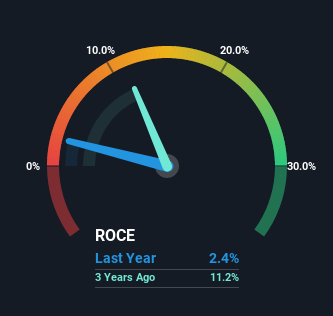K.C.P. Sugar and Industries (NSE:KCPSUGIND) Could Be At Risk Of Shrinking As A Company
What underlying fundamental trends can indicate that a company might be in decline? Typically, we'll see the trend of both return on capital employed (ROCE) declining and this usually coincides with a decreasing amount of capital employed. Basically the company is earning less on its investments and it is also reducing its total assets. So after we looked into K.C.P. Sugar and Industries (NSE:KCPSUGIND), the trends above didn't look too great.
Understanding Return On Capital Employed (ROCE)
If you haven't worked with ROCE before, it measures the 'return' (pre-tax profit) a company generates from capital employed in its business. The formula for this calculation on K.C.P. Sugar and Industries is:
Return on Capital Employed = Earnings Before Interest and Tax (EBIT) ÷ (Total Assets - Current Liabilities)
0.024 = ₹95m ÷ (₹5.8b - ₹1.8b) (Based on the trailing twelve months to June 2022).
Thus, K.C.P. Sugar and Industries has an ROCE of 2.4%. Ultimately, that's a low return and it under-performs the Food industry average of 14%.
Check out our latest analysis for K.C.P. Sugar and Industries

While the past is not representative of the future, it can be helpful to know how a company has performed historically, which is why we have this chart above. If you're interested in investigating K.C.P. Sugar and Industries' past further, check out this free graph of past earnings, revenue and cash flow.
What The Trend Of ROCE Can Tell Us
In terms of K.C.P. Sugar and Industries' historical ROCE movements, the trend doesn't inspire confidence. Unfortunately the returns on capital have diminished from the 7.9% that they were earning five years ago. And on the capital employed front, the business is utilizing roughly the same amount of capital as it was back then. Companies that exhibit these attributes tend to not be shrinking, but they can be mature and facing pressure on their margins from competition. If these trends continue, we wouldn't expect K.C.P. Sugar and Industries to turn into a multi-bagger.
Our Take On K.C.P. Sugar and Industries' ROCE
All in all, the lower returns from the same amount of capital employed aren't exactly signs of a compounding machine. It should come as no surprise then that the stock has fallen 16% over the last five years, so it looks like investors are recognizing these changes. That being the case, unless the underlying trends revert to a more positive trajectory, we'd consider looking elsewhere.
On a final note, we found 3 warning signs for K.C.P. Sugar and Industries (1 makes us a bit uncomfortable) you should be aware of.
For those who like to invest in solid companies, check out this free list of companies with solid balance sheets and high returns on equity.
Valuation is complex, but we're here to simplify it.
Discover if K.C.P. Sugar and Industries might be undervalued or overvalued with our detailed analysis, featuring fair value estimates, potential risks, dividends, insider trades, and its financial condition.
Access Free AnalysisHave feedback on this article? Concerned about the content? Get in touch with us directly. Alternatively, email editorial-team (at) simplywallst.com.
This article by Simply Wall St is general in nature. We provide commentary based on historical data and analyst forecasts only using an unbiased methodology and our articles are not intended to be financial advice. It does not constitute a recommendation to buy or sell any stock, and does not take account of your objectives, or your financial situation. We aim to bring you long-term focused analysis driven by fundamental data. Note that our analysis may not factor in the latest price-sensitive company announcements or qualitative material. Simply Wall St has no position in any stocks mentioned.
About NSEI:KCPSUGIND
K.C.P. Sugar and Industries
Manufactures and sells sugar and related products in India.
Excellent balance sheet and fair value.
Market Insights
Community Narratives



